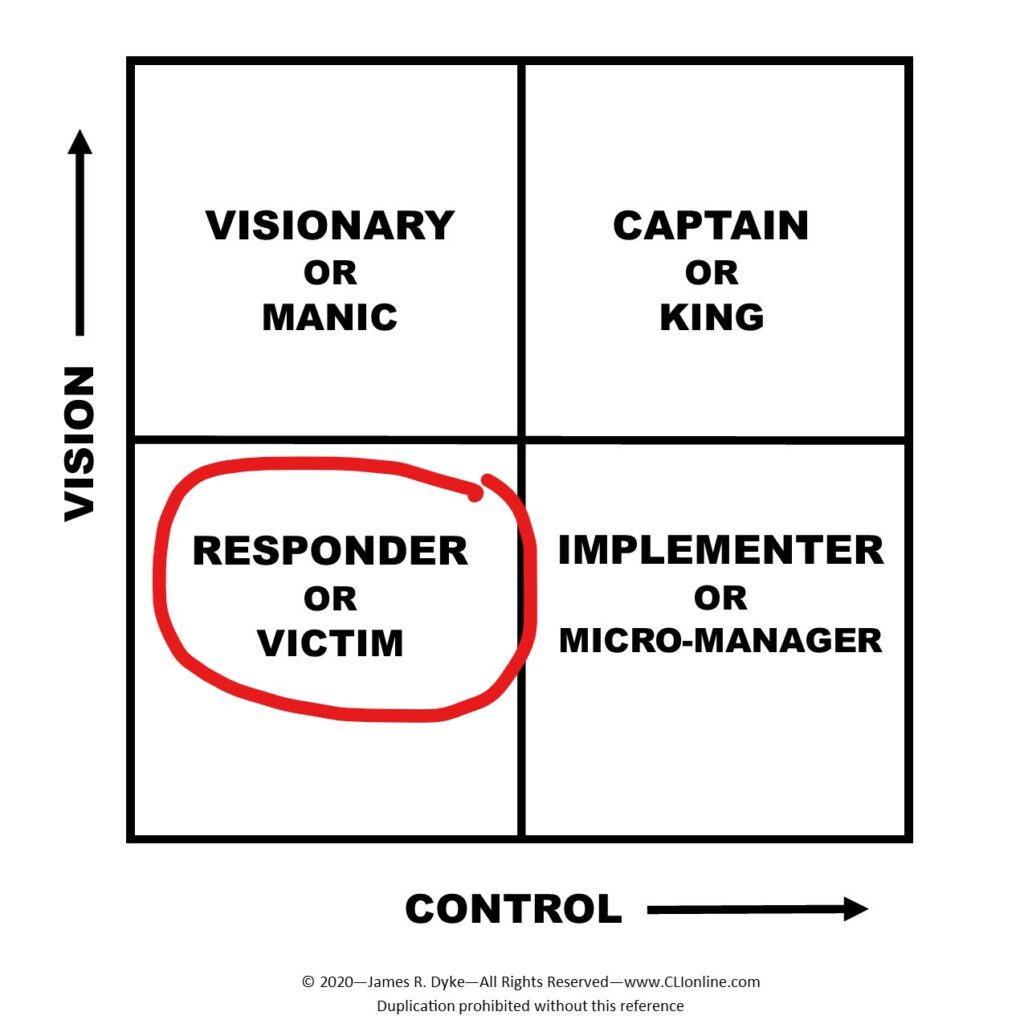Low Vision and Low Control

The Closed Door Policy
The Responder doesn’t exercise much control in their management or supervision. They are generally passive players in the organization. They are very often viewed as an absentee boss—sitting in their office, almost completely disconnected from their team. Because they offer little direct oversight—like the Visionary or Manic leader—they need a team of skilled and competent employees who can carry on the work without much support or interference from the boss. They are mostly “maintainers” of the processes and procedures they have inherited with their leadership role. They are not prone to do much trouble-shooting or updating. They usually don’t run interference for their team. (No one would ever view them as championing their people!) In fact, their employees have to really push them to get any support or advocacy from them.
Apply Slight Pressure HERE
The same is true for anyone in the organization who requires the services of The Responder—they have to exercise initiative to actively and assertively engage The Responder, in order to get the work they need from The Responder or their team. They have to push, because The Responder is not an initiator. Part of the passive nature of this type of leader is that they don’t anticipate the needs of the organization; the team; their colleagues; clients; or higher-ups. They tend to exist in the small universe of their own department—basically self-absorbed unless required to be otherwise by pressure from above.
You Get What You Push For
Their only redeeming quality is that they will RESPOND when goaded or coerced. They will “come to the party” if higher-ups put the squeeze on them and compel them to cooperate. But everyone knows they are doing so grudgingly, by virtue of coercion rather than enthusiastic accord. As a result, they are quickly labelled as “difficult” by everyone who works for them or with them.
Their future in the organization is secure only as long as their team continues to function effectively, and their department’s processes don’t become dated or obsolete. As long as they produce the required work, colleagues and higher-ups are often willing to tolerate their flaccid leadership, and simply commit to the extra energy it takes to work with them.

Their promotion is highly unlikely, however. And they may suffer termination if they are assigned to a new boss who tires of their inertia and lack of initiative.
“It’s Not My Fault!”
The Victim is the dysfunctional “shadow” of The Responder.
Like The Responder, The Victim is a passive and disconnected leader. The difference is that The Victim doesn’t have the skilled, effective, self-directing team they need in order to produce the required work. The problems they avoid addressing have reached the point where the work of the department is suffering as a result, and now it’s come to the attention of the boss and other higher-ups.
Pushing Won’t Help
Goading The Victim to produce doesn’t work because they don’t have the initiating energy to take personal responsibility for their leadership—to address problems; set priorities; make key decisions; or work collaboratively with their team. Instead, they are quick to blame their lack of initiative (and any lack of effectiveness) on other people and other situations. When given clear performance directives, they fail; shrug their shoulders; and complain “What can I do?” Termination for them is imminent.

I had an executive coaching client like this.
Don’t Become This Person!
He had been in his position a long time, enjoying the advantages of a long-term tenure, with a department that functioned without much oversight required. Then the business changed, and his department was required to take on new workload and incorporate a new technology. He was completely over his head. The supervisors he appointed to share the management load were also overwhelmed—unqualified; untrained; ill-equipped; and lacking any coaching or direction from their Victim leader. The Victim’s new boss took time to connect with him as well as his supervisorial team—to get a true sense of what was happening, and to give clear, straightforward performance goals to the leader. Despite my counsel to The Victim leader to take appropriate action, he failed in all of his performance goals; blamed his new boss for “unrealistic expectations and management interference;” and resigned before he could be terminated.
The Team is the Key to Success
Both The Responder and The Victim would do well to work towards becoming an effective Implementer. That would require them to start working more closely and directly with their team—to take a more active, collaborative role in their leadership. It would require them to have regular, effective team meetings; interactive communication with their employees; more direct, cooperative ties with other colleagues and teams; stronger advocacy for their people; and above all, the willingness to assume personal accountability for the success of their team.
As you consider this information:
- Do the descriptions of these manager/leaders bring to mind anyone you have seen or dealt with in your experience?
- Are the descriptions uncomfortably applicable to your own management style?
- Might the suggestions for improvement be helpful to your growth and development?
- Would it be useful to share the information with leaders you are managing?
If you want to become a more effective leader, or have more effective leaders working for you—contact us! We can provide leadership development ideas for you and your organization; effective training for your people; and executive coaching for YOU.
Until next time—yours for better leaders and better organizations!
Dr. Jim Dyke – “The Boss Doctor” ™ – Helping you to be a better boss and to have a better boss!


